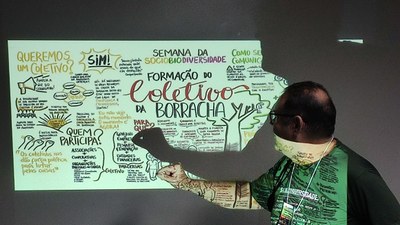Rubber Value Chain: Providing Sustainable Income and Keeping the Forest Standing
March, 2024 – A joint effort involving agro-extractive associations and partners in six municipalities in Amazonas state is yielding positive results for local communities, including increase in rubber production and generating direct income for participating families. The project contributes to protecting the standing forest and conserving biodiversity in the Amazon.
This is possible thanks to the Together for Amazon Rubber project [Juntos pelo Extrativismo da Borracha Amazônica]. The second state-wide meeting of rubber extraction was held in February in Manaus. In total, 16 agro-extractive associations are part of this effort, covering the municipalities of Canutama, Itacoatiara, Pauini, Manicoré, Barcelos, and Eirunepé.
Participants highlighted the need for collaborative actions with stakeholders to address issues such as tax reductions and logistical challenges to ensure the viability of their work, thus reinforcing the need to expand planning.
“If you don’t invest in the production chain, it won’t sustain itself. We need to think about rubber not just as rubber, but considering everything it represents, what and who is behind it, including, above all, the forest,” emphasizes José Roberto de Lima, president of the Association of Agroextractive Workers of Pauiní.
The event attracted 80 participants, including representatives of civil society, businesses, and public authorities. Raising awareness among federal, state, and municipal governments about the importance of meeting the sector's demands, and promoting recognition and appreciation for the work of rubber tappers in the Amazon was a goal.
The Together for Amazon Rubber project is supported by USAID, the Partnership Platform for the Amazon (PPA), the Alliance of Bioversity International and CIAT, the Consultative Group on International Agricultural Research (CGIAR), the Michelin Foundation, and Conexsus. It is managed by the National Council of Extractive Populations (CNS), the Chico Mendes Memorial, Michelin Brazil, Imaflora, and WWF-Brazil.
Over 500 families are benefiting from this initiative , through the direct conservation of more than 145,000 hectares in the Amazon through sustainable rubber management. The project’s environmental reach extends to over 1.3 million hectares, including four conservation units. In the second year, more than 130 tons of native rubber were produced, generating R$1.8 million in income for the participating families.
Letter – A communication was drafted with a list of demands for governments to strengthen the rubber chain, including tax exemption for sociobiodiversity products (in particular ICMS, a state sales tax applied to all goods and services in Brazil), and the provision of latex extraction equipment.
“I always say that rubber is our main product, as it has a strong symbolic meaning attached to our history of living in the Amazon. Building on that, we can truly start valuing our forest from a conservation perspective,” says Júlio Barbosa, president of the National Council of Extractive Populations (CNS) and one of the organizers of the meeting.



